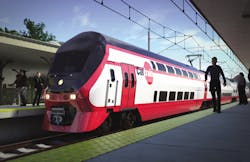Caltrain Modernization and Electrification: Bringing Relief to a Congested Region
Over the past 12 years, Caltrain ridership has doubled as businesses in the Bay Area have grown exponentially. Riders are packed onto standing room-only trains during peak hours. The traffic congestion on the freeways in San Francisco and San Jose regularly ranks among the worst in the nation. Relief is coming thanks to Caltrain’s electrification and modernization project. In July, community leaders and transportation officials broke ground on the $1.7 billion project in Millbrae, California.
“Gannett Fleming is proud to provide electrification and modernization services for Caltrain,” said Bryan Mulqueen, P.E., Gannett Fleming senior vice president and Transit & Rail Global Business Line director. “We are seizing the opportunity to boost ridership capacity, reduce the transit system’s carbon footprint, and help meet California’s emission reduction goals.”
The Caltrain electrification project spans from the 4th and King Street Station in San Francisco to the Tamien Station in San Jose and is scheduled to be completed in 2021. It will remove 619,000 vehicle miles per day and 176 metric tons of carbon dioxide emissions per year from the region. The modernization will support an increase in ridership from 60,000 daily riders along the 51-mile route to a projected 111,000 riders by 2040.
“Electrification allows trains to brake and accelerate more quickly than their diesel counterparts, so more trains can pass through at a quicker rate,” said Caltrain Modernization Project Delivery Director Dave Couch. “In addition, we are removing 176,000 metric tons of carbon dioxide emissions and reducing engine noise and congestion.”
Gannett Fleming provides local expertise and support out of its San Francisco area office, while also pulling on nationwide expertise from 13 additional offices. In late 2016, the Gannett Fleming Transit & Rail team facilitated the California Public Utilities Commission approval on electrical requirements related to the project’s railroad electrification initiative. This critical approval set the stage for construction and mobilizing the design-build contractor.
Gannett Fleming is also providing electrification program management services for the new system on 51 miles of Caltrain right of way. Caltrain will convert this route from a diesel push/pull service to two 25 kilovolt 60 hertz electrification systems. Significant modifications also will be made to the signal systems, SCADA systems, communications systems, and the back office and dispatching systems.
Special features of the Caltrain electrification include two major traction power substations and seven autotransformer substations, as well as modifications to 55 highway grade crossings.
Specifically, Gannett Fleming will perform the overall electrification program management services; creating bridging documents for design-build delivery method; advise on alternative delivery construction capabilities; provide risk management advice to the project owner; perform systems integration; coordinate with utilities and host railroads (UPRR); and provide construction management services. Our tasks also include overhead catenary system and traction power substation design, tunnel modifications, and a right of way survey.
The project recently secured federal grant funding of $647 million from the Federal Transit Administration’s Core Capacity Improvement Program, which provides grants to alleviate over-capacity transit corridors. In the long term, electrification also readies the corridor to accommodate California’s planned high-speed rail system, which will provide a one-seat ride from downtown San Francisco to Los Angeles.
Charles Lynch is the Caltrain electrification project manager at Gannett Fleming, San Francisco, Calif.




